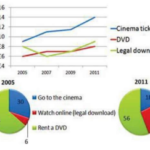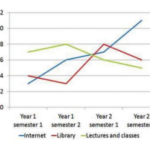Data is given for the distance travelled for three different reasons, as well as charts
indicating the percentage of vehicle types in the UK in 1990 and 2010.
The most significant trend is that the most kilometres were travelled for transporting
and delivery reasons. In 1990, this figure was approximately 6500 kilometres, rising
to almost 8000 kilometres by 1995 and 2000 but falling to 6,000 by 2010.
Personal travel accounted for about 1,200 kilometres amonth more than commuting
for 1990 to 2000, but commuting distances increased from 2000 to be within
approximately 700 kilometres of personal driving, with the former being on 3,000
and the latter being around 2,300.
The pie charts indicate that in the twenty year difference, the percentage of cars fell
by 4% while the number of trucks increased by 5%. Over the same period, buses and
motorcycles both fell by 1% while the category labelled ‘other’ increased by 1%.
Overall, it is clear that there was a number of changes in the distance travelled and
type of vehicles from 1990 to 2010.
(177 words)
Estimated IELTS Band Score: 7.5 – 8.0
- Task Achievement: 7.5 – Covers key trends well, but some comparisons could be more detailed.
- Coherence & Cohesion: 8.0 – Logically structured with clear progression.
- Lexical Resource: 7.5 – Good variety of vocabulary, but minor refinements needed.
- Grammar: 7.5 – Mostly accurate, with some minor improvements needed.
Band 8
The line graph and pie charts provide information on the number of kilometers traveled in an average month for different purposes, as well as the distribution of vehicle types in the UK in 1990 and 2010.
Overall, the highest distance traveled was for transport and delivery, although this declined after 2000. Meanwhile, commuting distances increased, and there were notable changes in vehicle distribution over the period.
In 1990, transport and delivery accounted for approximately 6,500 kilometers per month, peaking at nearly 8,000 in 1995 before declining to 6,000 by 2010. Personal travel consistently remained around 1,200 kilometers higher than commuting, but commuting distances increased steadily from 2000 onwards. By 2010, commuting travel had nearly equaled personal travel, with figures of around 2,300 kilometers and 3,000 kilometers, respectively.
The pie charts show that cars remained the dominant vehicle type, though their share dropped from 63% in 1990 to 59% in 2010. Over the same period, the proportion of trucks rose by 5%, while the shares of buses and motorcycles both declined by 1%. The “other” category saw a small increase of 1%.
In summary, there were notable shifts in both travel distances and vehicle type distribution between 1990 and 2010.
Word Count: 169
Band 9
The line graph illustrates the average monthly distance traveled in Britain for commuting, personal use, and transport/delivery from 1990 to 2010, while the pie charts display the percentage distribution of different vehicle types in 1990 and 2010.
Overall, transport and delivery accounted for the greatest distance traveled, although this figure declined after 2000. Meanwhile, commuting distances steadily increased, and there were noticeable shifts in the distribution of vehicle types over the period.
In 1990, transport and delivery travel stood at approximately 6,500 kilometers per month, rising to a peak of nearly 8,000 in 1995 before falling to 6,000 by 2010. Personal travel consistently remained around 1,200 kilometers higher than commuting. However, from 2000 onwards, commuting distances increased, reaching around 2,300 kilometers per month by 2010, almost equaling personal travel, which stood at 3,000 kilometers.
The pie charts reveal a decline in the proportion of cars, dropping from 63% in 1990 to 59% in 2010. In contrast, the percentage of trucks rose by 5%, while buses and motorcycles both saw slight declines of 1%. The “other” category experienced a modest increase of 1%.
In conclusion, while transport and delivery travel remained the dominant category, commuting distances grew significantly, and there were moderate shifts in the types of vehicles used.
Word Count: 170
Comparison Table
| Feature | Band 7-8 Version | Band 9 Version |
|---|---|---|
| Vocabulary | Clear and simple terms | More precise and academic vocabulary |
| Sentence Structure | Mostly straightforward | More complex and varied structures |
| Data Presentation | Covers key trends well | More precise use of figures and trends |
| Clarity & Cohesion | Smooth and logical flow | More refined and concise phrasing |
Examples from Essays
| Aspect | Band 7-8 Example | Band 9 Example |
|---|---|---|
| Sentence Structure | “Meanwhile, commuting distances increased, and there were notable changes in vehicle distribution over the period.” | “Meanwhile, commuting distances steadily increased, and there were noticeable shifts in the distribution of vehicle types over the period.” |
| Data Presentation | “By 2010, commuting travel had nearly equaled personal travel, with figures of around 2,300 kilometers and 3,000 kilometers, respectively.” | “By 2010, commuting distances increased, reaching around 2,300 kilometers per month by 2010, almost equaling personal travel, which stood at 3,000 kilometers.” |
| Clarity & Cohesion | “In summary, there were notable shifts in both travel distances and vehicle type distribution between 1990 and 2010.” | “In conclusion, while transport and delivery travel remained the dominant category, commuting distances grew significantly, and there were moderate shifts in the types of vehicles used.” |
Grammar Mistakes
- Original: “Data is given for the distance travelled for three different reasons, as well as charts indicating the percentage of vehicle types in the UK in 1990 and 2010.”
Correction: “Data are given for the distance traveled for three different purposes, as well as charts showing the percentage of vehicle types in the UK in 1990 and 2010.” (Fixed singular/plural issue: “Data” is plural in formal writing, and “reasons” is better replaced with “purposes.”) - Original: “Personal travel accounted for about 1,200 kilometres a month more than commuting for 1990 to 2000, but commuting distances increased from 2000 to be within approximately 700 kilometres of personal driving.”
Correction: “Personal travel exceeded commuting distances by approximately 1,200 kilometers per month from 1990 to 2000, but after 2000, commuting distances increased, reducing the gap to about 700 kilometers.” (Improved clarity and readability.) - Original: “The pie charts indicate that in the twenty year difference, the percentage of cars fell by 4% while the number of trucks increased by 5%.”
Correction: “The pie charts indicate that over the twenty-year period, the proportion of cars declined by 4%, while the percentage of trucks rose by 5%.” (More precise and natural phrasing.)
Vocabulary Repetition
| Repeated Word | Suggested Alternatives |
|---|---|
| “Increase” | Rise, Surge, Growth, Climb |
| “Decline” | Drop, Decrease, Reduction, Fall |
| “Travel” | Transportation, Journey, Movement |
IELTS Writing Task 1 Exercises with Answers
Fill in the blanks using appropriate words:
- The line graph _______ (illustrates/shows) the distance traveled for three different purposes in Britain from 1990 to 2010.
Answer: illustrates - The distance traveled for transport and delivery _______ (peaked/dropped) at nearly 8,000 kilometers in 1995.
Answer: peaked - By 2010, commuting distances had _______ (risen/fallen) to nearly 2,300 kilometers per month.
Answer: risen - The proportion of trucks _______ (increased/decreased) by 5% between 1990 and 2010.
Answer: increased


